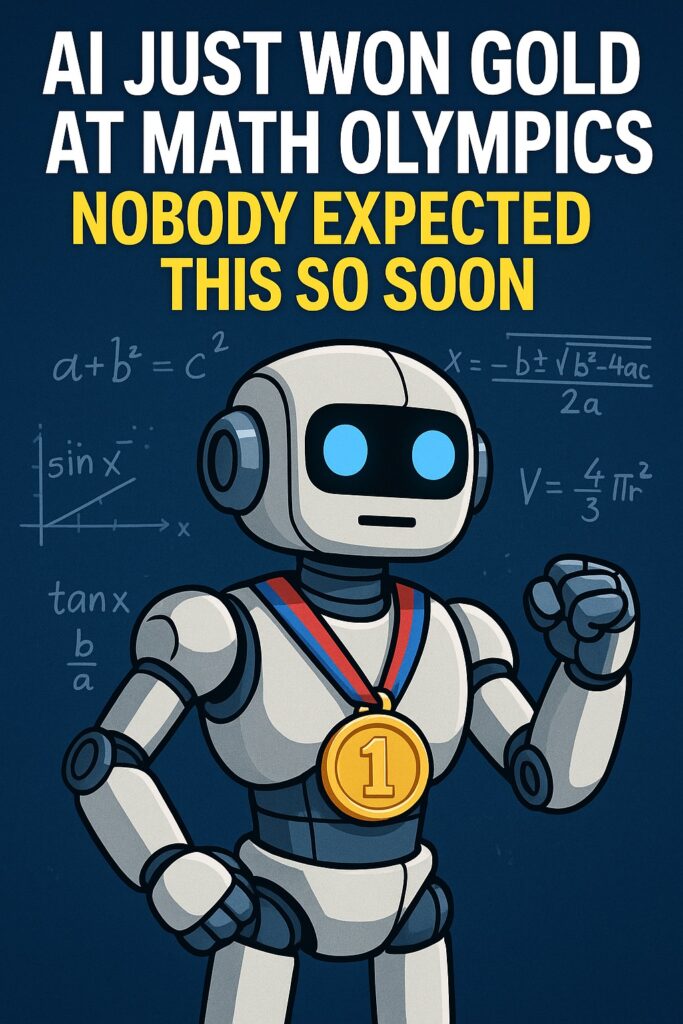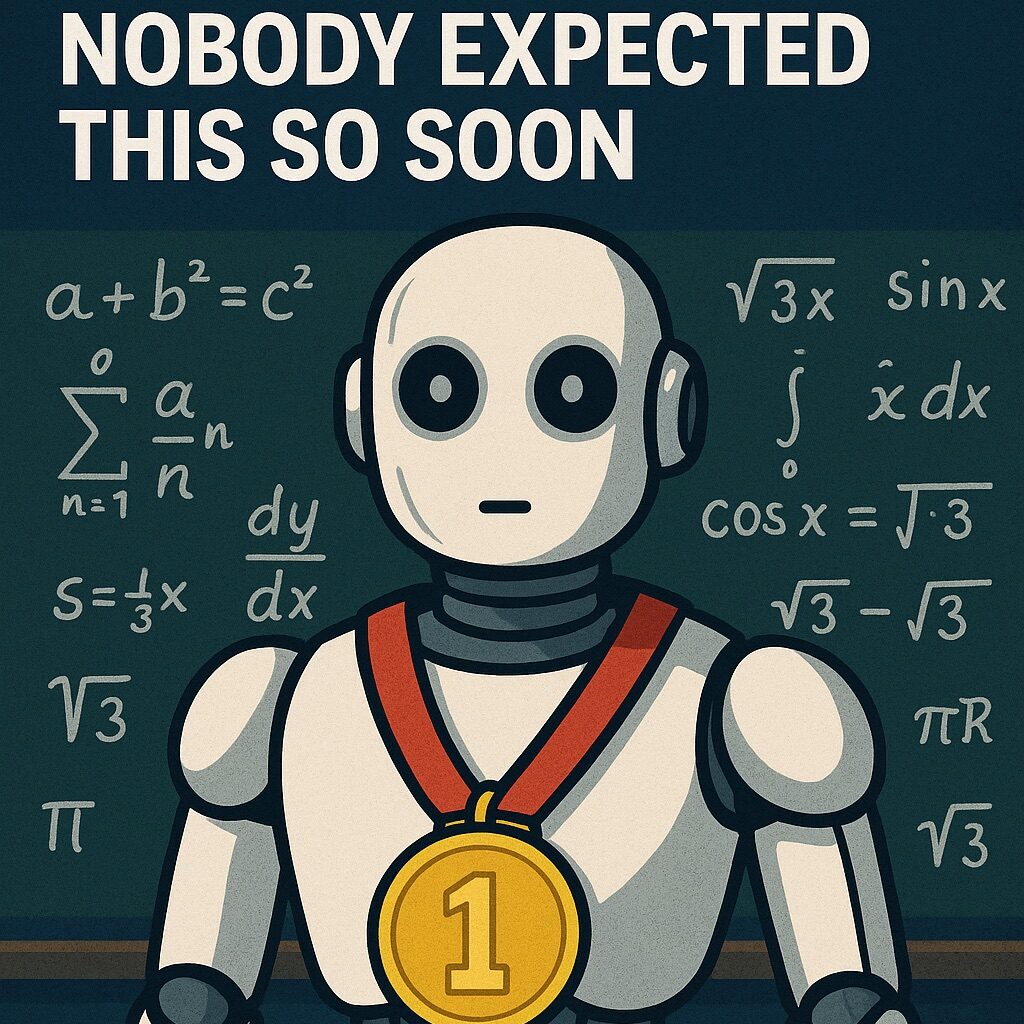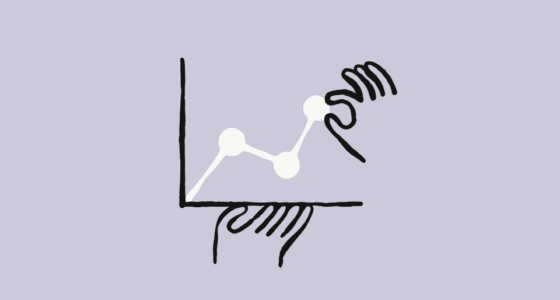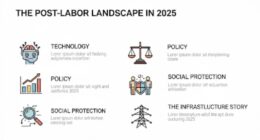Two AI systems just accomplished something that mathematicians didn’t think was possible for years. OpenAI’s experimental reasoning model and Google’s Deep Thinking model both earned gold medal performance at the International Math Olympiad, solving 5 out of 6 problems using pure mathematical reasoning. Their solutions were independently verified by former IMO medalists, confirming this achievement. No external tools, no human assistance – just raw computational thinking that rivals the world’s brightest mathematical minds. Experts call this a major leap forward because it pushes AI’s reasoning beyond past time-scale limits, signaling something fundamental has changed in artificial intelligence capabilities. But to understand why this matters so much, you need to grasp just how elite this competition really is.
The Math Olympiad Challenge That Stumped Experts for Decades
The International Math Olympiad represents such an extreme level of mathematical thinking that most brilliant mathematicians can’t even qualify for their national teams. We’re talking about people who’ve spent decades mastering advanced mathematics, who teach at elite universities, who publish groundbreaking research. Yet only six teenagers per country make the cut each year. Now picture AI systems not just participating in this competition, but actually winning gold medals.
IMO problems require multi-page proofs that demand hours of sustained creative thinking. Contestants must construct elegant logical arguments from scratch, often involving geometric constructions, number theory insights, or combinatorial reasoning that would challenge professional mathematicians. These aren’t calculation problems where you plug numbers into formulas. They’re open-ended challenges that require genuine mathematical creativity and the ability to see patterns that aren’t immediately obvious. Both AI systems faced the exact same constraints as human competitors: 4.5 hours to solve their problems, no internet access, no computational tools or calculators, no ability to look up theorems or reference materials.
What makes this achievement remarkable is the jump in reasoning time it represents. As researcher Alexander Wei noted, AI has progressed from benchmarks requiring minutes of reasoning to problems demanding around 100 minutes for IMO-level solutions. This signals a fundamental leap in sustained creative thinking that caught experts off guard.
This benchmark has been the holy grail of mathematical AI since researchers first proposed it. Succeeding at the IMO requires everything that makes human mathematical thinking special: creativity, persistence, the ability to try multiple approaches when one doesn’t work, and the insight to recognize when you’re on the right track. It’s exactly the kind of problem that AI researchers thought would remain out of reach for years to come.

The timeline acceleration here is staggering. Experts like Paul Christiano and Eliezer Yudkowsky predicted only an 8 to 16 percent chance of AI achieving this level by 2025. Even Terence Tao, who became the youngest IMO participant ever at age 10 and later won a Fields Medal, didn’t see this coming. Tao had specifically predicted that AI would struggle with long-form mathematical proofs because they require sustained reasoning over extended periods.
The technical advances we’re seeing represent something fundamentally different from previous AI capabilities. These systems can now engage in extended reasoning processes that mirror how human mathematicians actually work through difficult problems. They can spend time exploring different approaches, backtrack when they hit dead ends, and maintain coherent logical threads across hours of thinking.
The most remarkable part? Both OpenAI and Google achieved this independently using different approaches. Both systems solved 5 out of 6 problems, earning verified gold medal performance that puts them among the mathematical elite. This suggests we’ve crossed a threshold that multiple research teams can now reach, indicating a genuine breakthrough in AI reasoning capabilities. But the real question is: how did these systems learn to think for such extended periods?
The Reinforcement Learning Revolution That Changed Everything
The breakthrough lies in a fundamental shift in how these AI systems process information. When you ask GPT-4 a question, you get an instant response. The model processes your input and spits out an answer in milliseconds. But these new AI systems work completely differently. They can sit with a problem for extended periods, exploring different approaches, testing ideas, and gradually building toward a solution. As research lead Alexander Wei noted, we scaled reasoning time from seconds in earlier benchmarks to over 100 minutes at IMO level.
This represents a massive leap from previous AI capabilities. Traditional models operated like lightning-fast calculators, processing information and producing immediate outputs. These new systems can deliberate and reason over extended periods, maintaining focus on a single problem while exploring multiple solution paths. They can backtrack, explore multiple solution paths, and maintain coherence over hours of sustained thinking.
The technical breakthrough involves moving beyond simple reward-based training methods. Traditional reinforcement learning worked great when you had clear feedback signals. Train an AI to play chess, and you know immediately whether a move leads to winning or losing. But mathematical proofs present a completely different challenge. There’s no simple right or wrong answer that a computer can instantly verify. These proofs require subjective evaluation that can take human experts hours to complete properly.
Here’s why this creates such a difficult training problem. When an AI generates a mathematical proof, how do you know if it’s correct? Unlike the Automatic Math Evaluation benchmark where answers are simple integers, IMO problems involve multi-page arguments that require deep mathematical understanding to evaluate. Human mathematicians spend hours grading these proofs, looking for logical gaps, checking each step of reasoning, and verifying that the conclusions actually follow from the premises.
OpenAI developed new techniques enabling the model to learn from hard-to-verify, multi-page proofs—techniques that extend reinforcement learning beyond simple win/loss feedback. This breakthrough enables the models to craft intricate, watertight arguments at the level of human mathematicians, even when the training process can’t immediately determine whether those arguments are correct.
The progression in reasoning time tells an incredible story. Basic math problems that top human solvers complete in approximately 0.1 minutes can now be handled almost instantly by AI. But IMO-level problems require around 100 minutes of computational thinking. This represents a thousand-fold increase in reasoning time, showing that these systems can sustain complex thought processes over extended periods without losing focus or coherence.
This shift represents something fundamental about AI development. We’re moving from narrow, domain-specific systems to general-purpose reasoning capabilities. The OpenAI model wasn’t specifically designed for mathematical competitions. Instead, it incorporates experimental general-purpose techniques that enhance how language models handle complex reasoning tasks across multiple domains.
The efficiency improvements make this extended thinking computationally feasible. Earlier attempts at long-form AI reasoning were prohibitively expensive, requiring massive computational resources for marginal improvements. These new approaches achieve better results while using resources more efficiently, suggesting this capability can scale to tackle even more complex problems. But here’s what makes this achievement even more remarkable: OpenAI wasn’t working alone.
OpenAI vs Google: Two Paths to Mathematical Genius
Google simultaneously achieved a similar breakthrough with their own approach, though the specific details of their methodology remain less public. What are the odds that two completely independent research teams would crack the same incredibly difficult problem at almost exactly the same time? This kind of simultaneous breakthrough suggests we’re witnessing something much bigger than a lucky discovery.
OpenAI’s approach reveals fascinating insights about the future of AI development. Jerry Torque, an OpenAI staff member, noted that they did “very little IMO specific work” and instead concentrated on training general models. Their approach wasn’t about creating a math competition specialist. Instead, they developed broader reasoning capabilities that happened to excel at mathematical problems. This general-purpose system used no IMO-specific fine-tuning, relying instead on new reinforcement learning and compute-scaling breakthroughs.
Here’s what makes OpenAI’s approach particularly intriguing: their model uses natural language proofs while maintaining mathematical rigor without formal verification systems. Traditional mathematical AI relied on symbolic manipulation and formal proof checkers to ensure correctness. OpenAI’s system generates proofs in natural language, the same way human mathematicians communicate their reasoning. This represents a significant departure from previous approaches that required rigid mathematical notation and computer-verifiable steps.
The fact that OpenAI achieved this without any IMO-specific training or narrow domain optimization changes everything. We’re not looking at a system that was carefully tuned for mathematical competitions. This is a general reasoning model that demonstrated mathematical excellence as a byproduct of its broader capabilities. What does this tell us about its potential applications? If this system can reason through complex mathematical proofs without specialized training, it might tackle scientific research, engineering problems, and theoretical challenges across completely different fields.
The verification challenge OpenAI had to solve reveals the sophistication of their training methods. Mathematical proofs can take human experts hours to grade properly. Unlike simple math problems with clear numerical answers, these proofs require subjective evaluation of logical arguments, creative insights, and mathematical elegance. As researcher Nome Brown explained, OpenAI developed new techniques that allow their reasoning model to learn from these hard-to-verify tasks, representing a major advancement in training methods that extends reinforcement learning beyond simple win-loss feedback.
This achievement points to a fundamental conclusion: we’ve crossed a threshold in AI reasoning abilities rather than stumbled upon a mathematical trick that works for one specific competition. The implications extend far beyond mathematics, suggesting these systems might soon tackle complex problems across science, engineering, and research domains that were previously thought to require human-level creativity and insight.
The timing of this breakthrough has sent shockwaves through the AI research community, with industry leaders scrambling to understand what this means for the future of artificial intelligence development.
Why This Changes Everything About AI Development
These offers reflect an unprecedented scramble for top AI talent, signaling labs see massive changes on the horizon. Over ten OpenAI researchers were offered $300 million packages from Meta to jump ship. Think about that number for a moment. We’re talking about individual researchers being offered more money than most companies are worth. Yet many of them declined these offers. What does this tell us about what’s happening behind closed doors at these AI labs? The talent war has reached unprecedented levels because industry leaders recognize we’re witnessing something extraordinary.
AI researchers aren’t calling this progress incremental anymore. They’re using the term “phase shift” to describe what’s unfolding. Former Stability founder Ahmad Mustagh warned that timelines are accelerating faster than anyone anticipated, with the IMO success serving as a wake-up call for the entire industry. This language suggests something fundamental has changed in AI development trajectory. We’re not looking at gradual improvements where models get slightly better at existing tasks. Instead, we’re seeing capabilities emerge that weren’t there before. The IMO achievement represents this shift perfectly. These systems didn’t just get better at math. They developed reasoning abilities that mirror human mathematical thinking in ways that seemed impossible just months ago.
Here’s why this matters more than you might realize. There’s a critical difference between AI that performs slightly below human level versus slightly above human level in scientific domains. Once AI crosses that threshold, even by a small margin, it can start contributing to actual scientific discovery. Picture AI systems analyzing complex data patterns that human researchers might miss, generating hypotheses that wouldn’t occur to human scientists, or working through theoretical problems at speeds that accelerate research timelines dramatically.
Sam Altman has made a bold prediction about this timeline. He believes 2025 to 2026 will mark the year AI begins contributing to genuine scientific discovery. What does this mean practically? Imagine AI systems actively participating in research rather than just assisting human scientists. These systems could analyze experimental data, propose novel approaches to unsolved problems, and even design new experiments to test their hypotheses. The mathematical reasoning breakthrough opens doors to physics simulations, chemistry modeling, biological system analysis, and engineering optimization problems.
Some experts are making an even bolder claim about what we’re witnessing. They argue this level of reasoning already constitutes artificial general intelligence. Will Brown, a reinforcement learning specialist at Prime Intellect, stated, “I’m much more inclined to say that the RL system inside OpenAI is AGI rather than any fixed model checkpoint which comes out of it.” If he’s right, we’ve already crossed one of the most significant milestones in AI development without fully recognizing it.
We’re witnessing the transition from AI as a sophisticated tool to AI as a scientific collaborator capable of genuine discovery. This shift changes everything about how we think about artificial intelligence and its role in advancing human knowledge. But here’s what makes this even more intriguing: the companies at the center of these breakthroughs are starting to manage expectations in surprising ways.
The GPT-5 Connection and What Comes Next
Sam Altman did something interesting after the IMO breakthrough became public. Instead of celebrating this massive achievement, he shifted into expectation management mode for GPT-5. Why would the CEO of OpenAI downplay such a remarkable success? The answer reveals something fascinating about the timeline of AI development. Altman emphasized this system is experimental, uses techniques that will feed into future models, and that GPT-5 won’t reach this level for many months. The capabilities demonstrated were more advanced than what would be available in GPT-5 for several months.
Think about what this means. OpenAI has developed reasoning capabilities that surpass what they’re planning to release in their next major model. The IMO-winning system represents experimental techniques that won’t reach consumers for many months. This suggests a strategic approach where public releases lag behind internal research capabilities by significant margins. What are they holding back, and why?
Rumors circulating in AI circles suggest GPT-5 might represent a completely different approach to model architecture. Hyperbolic Labs’ Euchen Jin suggests GPT-5 may use multiple sub-models with an internal router to optimize for reasoning vs. tool use. Picture an AI system that intelligently decides which specialized model to use for different tasks. Need quick factual information? Route to the fast response model. Working through complex reasoning? Switch to the deliberative thinking system. This architecture could optimize both performance and efficiency.
Here’s why OpenAI researchers are declining those $300 million offers. They’re working on something they believe will be even more significant than what we’ve already seen. When talented people turn down generational wealth to stay at their current job, they must see something extraordinary on the horizon. What does this tell us about the internal roadmap at these companies?
The AI evaluation landscape is evolving to match these new capabilities. The new ARC-AGI 3 benchmark represents a major shift in how we test artificial intelligence. Instead of static puzzles with clear solutions, this benchmark focuses on interactive reasoning and adaptability. It tests world model building and long-horizon planning under sparse feedback. The goal is assessing how well AI can handle dynamic, real-world scenarios that require learning new rules on the fly.
What makes this benchmark particularly challenging is its emphasis on novelty and adaptation. Traditional AI benchmarks test knowledge and pattern recognition. ARC-AGI 3 tests something closer to genuine understanding and flexible thinking. The creators describe it as having the widest gap between human and AI performance, suggesting it represents the next frontier of AI capabilities.
The broader pattern reveals AI capabilities advancing faster than even optimistic predictions suggested. Each new benchmark that falls opens up possibilities that seemed distant just months earlier. We’re not watching gradual improvements anymore. The mathematical reasoning breakthrough, combined with these architectural innovations and evaluation methods, suggests something fundamental has shifted in how these systems operate. The question isn’t whether this will expand beyond mathematics, but how quickly these capabilities will transform other domains of human knowledge.
Conclusion
The implications stretch across every professional field you can imagine. We just witnessed AI cross a line that changes everything. These systems aren’t sophisticated pattern matchers anymore. They’re genuine reasoning machines capable of mathematical discovery that rivals human thinking. What does this mean for your field? If AI can spend hours solving humanity’s most challenging mathematical problems, every industry becomes fair game. Engineers, researchers, doctors, lawyers – the reasoning capabilities we’ve seen will expand into your domain sooner than you think. The question isn’t whether this will happen. It’s how quickly. Could it soon diagnose diseases, design new materials, or rewrite the laws of physics? What will your field look like when AI can think for hours on end? If you found this analysis insightful, hit subscribe to stay updated on AI’s next breakthroughs.









